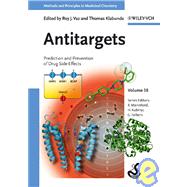
Note: Supplemental materials are not guaranteed with Rental or Used book purchases.
Purchase Benefits
What is included with this book?
Thomas Klabunde obtained his PhD in chemistry from the University of M? (Germany). After a postdoctoral fellowship at the Texas A&M University, he was appointed Assistant Professor at the Institute for Bioscience and Technology in Houston (USA). Later on, he joined the pharmaceutical research of Sanofi-Aventis in Frankfurt (Germany), where he is currently a group leader. His main interest lies with drug design approaches for G protein-coupled receptors, notably in the areas of lead finding and chemogenomics.
| List of Contributors | |
| Preface | |
| A Personal Foreword | |
| General Aspects | |
| Why Drugs Fail - A Study on Side Effects in New Chemical Entities | |
| Introduction | |
| Drugs Withdrawn from the Market between 1992 and 2006 Listed Alphabetically | |
| Borderline Cases | |
| Investigational Drugs That Failed in Clinical Phases from 1992 to 2002 | |
| Strategies for Avoiding Failure | |
| An Unusual Case: The Revival of Thalidomide | |
| References | |
| Use of Broad Biological Profiling as a Relevant Descriptor to Describe and Differentiate Compounds: Structure-In Vitro (Pharmacology-ADME)-In Vivo (Safety) Relationships | |
| Introduction | |
| Structure-In Vitro Relationships | |
| Chemogenomic Analysis - Target-Target Relationships | |
| In Vitro-In Vivo Relationships - Placing Drug Candidates in the Context of BioPrint | |
| A Perspective for the Future | |
| References | |
| Antitargets: Ion Channels and GPCRs | |
| Pharmacological and Regulatory Aspects of QT Prolongation | |
| Introduction | |
| hERG: Target Versus Antitarget | |
| Pharmacology of QT Prolongation | |
| Significance of Drug-Induced QT Prolongation | |
| Regulatory Aspects of QT Prolongation | |
| Conclusions | |
| References | |
| Introduction | |
| hERG Channel Structure | |
| hERG Potassium Channels and the Cardiac Action Potential | |
| Mutations in hERG Are Associated with Cardiac Arrhythmias | |
| Acquired Long QT Syndrome | |
| Drug-Binding Site of hERG | |
| Structural Basis for hERG Block | |
| Alternative Mechanisms of Block | |
| Role of Inactivation in hERG Block | |
| Inhibition of hERG Trafficking by Pharmacological Agents | |
| Computational Approaches to Predict hERG K? Channel Block | |
| Conclusions | |
| References | |
| QSAR and Pharmacophores for Drugs Involved in hERG Blockage | |
| Introduction | |
| Ligand-Based Models for hERG-Blocking Activity | |
| Ligand-Derived Models in the Light of the hERG Channel Structure | |
| Conclusions | |
| References | |
| GPCR Antitarget Modeling: Pharmacophore Models to Avoid GPCR-Mediated Side Effects | |
| Introduction: GPCRs as Antitargets | |
| In Silico Tools for GPCR Antitarget Modeling | |
| GPCR Antitarget Pharmacophore Modeling: The a1a Adrenergic Receptor | |
| Summary | |
| References | |
| The Emergence of Serotonin 5-HT2B Receptors as DRUG Antitargets | |
| Receptorome Screening to Identify Drug Targets and Antitargets | |
| Post-Receptorome Screening Data Implicate 5-HT2B Receptors in Drug-Induced VHD and PH | |
| Drug Structural Classes and VHD/PH | |
| Conclusions | |
| References | |
| Table of Contents provided by Publisher. All Rights Reserved. |
The New copy of this book will include any supplemental materials advertised. Please check the title of the book to determine if it should include any access cards, study guides, lab manuals, CDs, etc.
The Used, Rental and eBook copies of this book are not guaranteed to include any supplemental materials. Typically, only the book itself is included. This is true even if the title states it includes any access cards, study guides, lab manuals, CDs, etc.